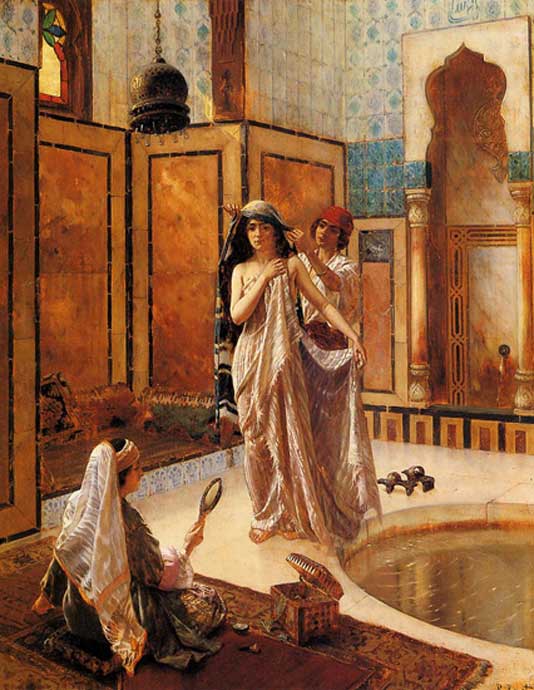
Romance of the Beautiful Slave and the Rebellious Ruler: Al-Khayzuran and Al-Mahdi
Arabian Nights conjure up images of romantic love stories of slave girls’ rags to riches journeys of the heart. We celebrate Valentine’s Day with the real love story of such a slave girl. It was not only Al-Khayzuran’s physical beauty - slender and graceful as a reed - but also her intelligence, wit and sense of humor that conquered the heart and mind of Caliph Al-Mahdi in the mid-8th century.

The Harem Bath by Rudolph Ernst (1854-1931) (Public Domain)
Although the subject of strong women in history is always fascinating, it is a widely recognized but often forgotten fact that the greatness of a queen could not have occurred without the positive support of the male population, just as a king’s power could be maintained only because women also supported him. No power would survive for long against the apathy or opposition of half of the population. Therefore, although sons, brothers and grandsons were the only ones with an officially recognized right to inherit power, the ancient East also experienced many female leaders who were successful rulers of kingdoms. In fact, Islamic history is riddled with crises that threatened to destroy a number of dynasties had it not been for the intervention of women.
None of the women of the Abbasid caliphate have gone down in history quite like Al-Khayzuran bint Atta. She was a slave who captured the heart of Caliph Al-Mahdi (744 to 785), who proceeded to break all conventions of the Abbasid dynasty by freeing her and making her his wife. Al-Khayzuran was then known for the visible role she played in various aspects of running the caliphate both through her own intelligence and supported by her husband′s high regard for her.

The Abbasid caliphate in the late 8th century (CC BY-SA 3.0)
From Slave to Favorite Concubine
The story of Al-Khayzuran is one of rags to riches. We do not know much about her early life except that she was born in the south-western part of the Arabian Peninsula around the middle of the 8th century, only a little more than a hundred years after the death of the Prophet Muhammad. It was possible that Al-Khayzuran was sold by her family into slavery, either as a means of reducing the financial burden on the family or to pay familial debts. Al-Khayzuran became the slave of an unnamed Arab who purchased her from the Yemen region and sold her to the ruling Caliph Al-Mansur for his son Al-Mahdi during his pilgrimage to Mecca. Conflicting accounts were made of Al-Khayzuran’s ethnicity - one stated she was a Berber from North Africa, while another claimed she was a Greek from the city of Jerash. Al-Khayzuran’s ethnicity was important at the slave market in Mecca, as slave women were characterized by the regions from which they originated.
The 7th century Umayyad Caliph Abd Al-Malik ibn Marwan (646 - 705 AD) once proclaimed that certain qualities valued in slave women were associated with their place of origin - Berbers for procreation, Greeks for their service and Persians for their good behavior. Later, Ibn Butlan, a physician who was active in Baghdad during the Islamic Golden Age, went so far as to provide characteristics of slave women from various regions - Berber women were characterized for their dark complexions, obedience and spirit, Yemeni women were similarly obedient with the addition of attractive faces and Byzantine women were characterized as having straight blonde hair. Therefore, Al-Khayzuran would have been promoted, displayed and sold for her physical attributes. Even the name for which she became remembered in history, is a physical description of her body - the word khayzuran means “reed”. Al-Khayzuran was a desired commodity not only for her physical features, but also due to her not having any familial ties. At the time of her purchase, Al-Mansur questioned Al-Khayzuran about her living relatives to which she lied that she had none. Al-Mansur’s inquiry into the living relatives of Al-Khayzuran served to protect his dynasty from her male relatives, who could potentially pose a threat to this dynasty.





